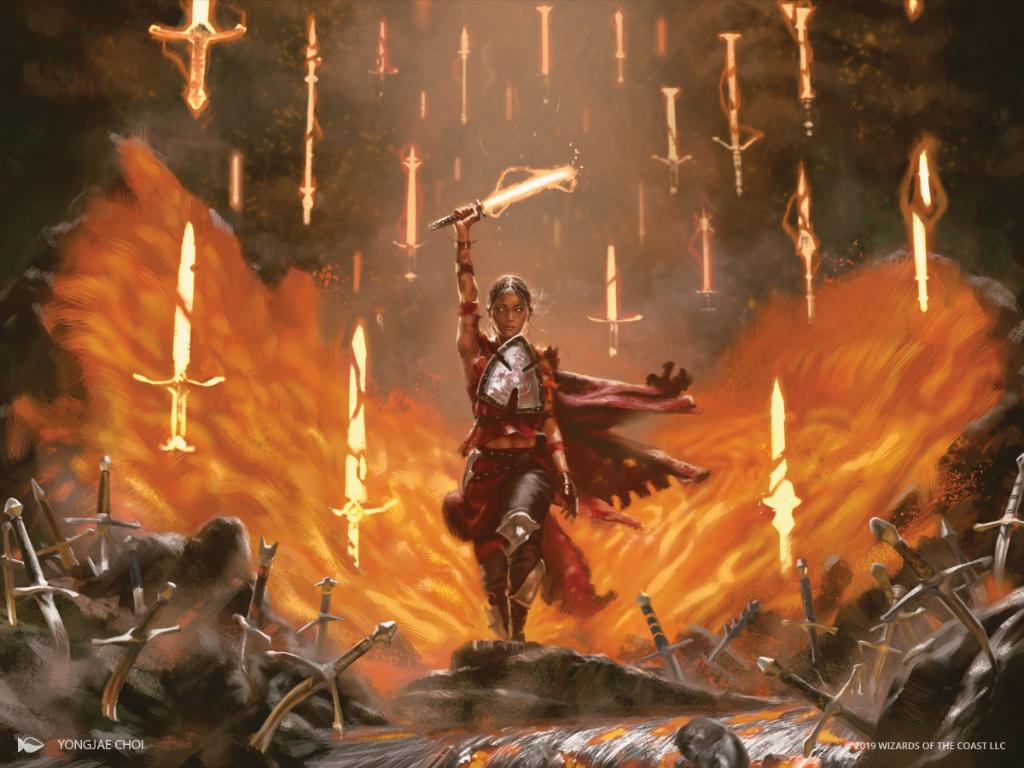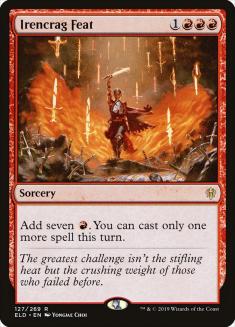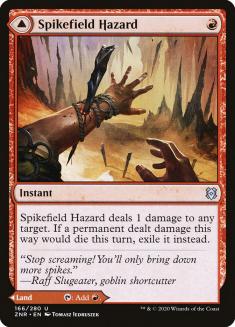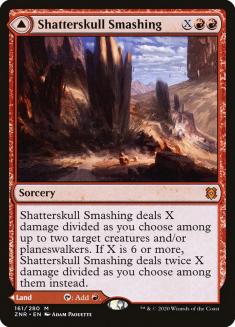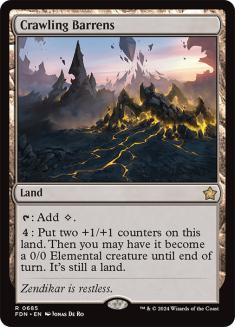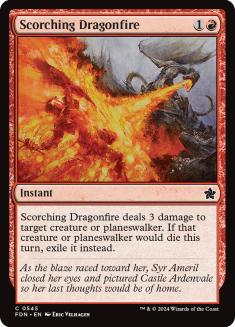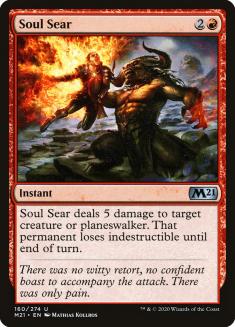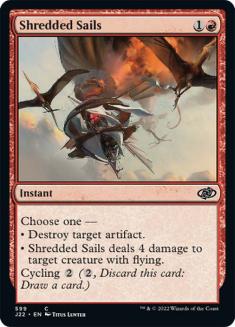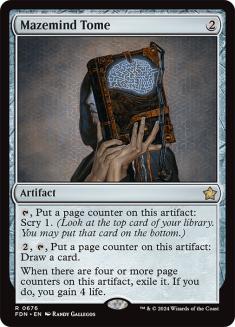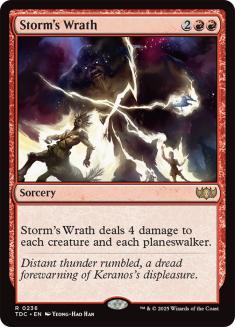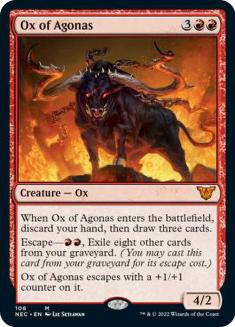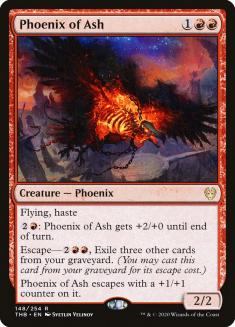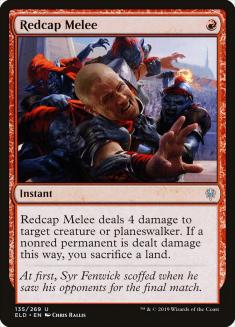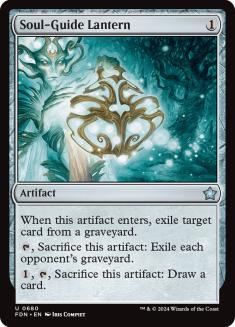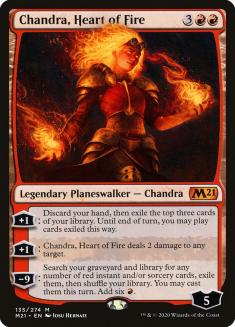I gotta say it. They’ve done it. Wizards of the Coast (WotC) finally made a Standard format worth getting invested in.
I’m trying out new strategies and seeing strong play patterns from both sides that involve interaction, combat, and resource management. Over the course of the last few years, the times in which any of those aspects mattered outside of “kill the opposing mana creature” was few and far between. It seemed that removal spells like Heartless Act or Eliminate would mostly just buy you one turn so you could slam Nissa, Who Shakes the World and ride it to victory.
Back and forth. That’s what I missed. I missed close games and topdecks and finding the right piece of interaction at the right time. For me, the tension between both players as they struggle for supremacy is the game. That’s the whole thing. That’s the reason for the London Mulligan and lands that act like spells and mana sinks and everything. Magic is all about achieving priority and doing everything in your power to maintain it until the game ends in your favor.
And we’re back.
The games themselves have been fun, which is a stark contrast (in my experience) from the last two years. The last time I remember being excited about Standard was Ravnica Allegiance. While Wilderness Reclamation was my pet card, and ultimately became a pillar of the format in a bad way, the sheer number of viable decks was astounding. On top of that, the interaction was good and trying to interact was worthwhile. Over the last few weeks, that’s the exact feeling I’ve gotten out of Standard once again, and I’m flying.
The Advent of Big Red
After hearing about the new SCG Tour Online structure and format(s), I decided it was high time to get back in the driver’s seat. I signed up for one of the satellite events and started looking for a cool deck to play. The second satellite of the day featured one of the coolest decks I’d seen in some time, and they were 5-0 at the time to boot. How could I not try out a Big Red deck featuring my boy Sad Robot!?
Creatures (10)
Planeswalkers (4)
Lands (20)
Spells (26)

Any format where Solemn Simulacrum is good is a format I want to play. The ramp aspect of Solemn Simulacrum is usually the most important, because the types of decks that want to play Solemn Simulacrum often want that extra mana right around the time and turn it gives it to you. The interesting thing about Solemn Simulacrum is that it can provide you some serious card advantage against decks that play smaller creatures. Being able to trade the 2/2 body for an actual card means Solemn Simulacrum can trade three-for-one.
In a world of Omnath, Locus of Creation, card advantage like that just doesn’t matter as much because a single card can and regularly does provide you with three cards’ worth of mana, battlefield advantage, and resources in hand or the battlefield.
The ease of generating that card advantage directly impacts how good or bad that type of resource generation is in a given game or format. Oko, Thief of Crowns, for example, is a three-mana spell that often generates three or more pieces of “card advantage” without dying. That effectively invalidates any more expensive card that does something similar. Omnath similarly generated a ton of mana, drew a card, and gained some life.
All I can say is that if you ban enough stuff where Solemn Simulacrum is good, you might have a fine format on your hands.
But we’re talking about Big Red and its role in Zendikar Rising Standard! We’re focusing on the here and now. And right now, this Big Red deck is absurd. If you want to beat Gruul Adventures, Big Red is the place to be. Not only do you have heavy hitters like Ugin, the Spirit Dragon that are hard to kill and completely decimate your opponent’s battlefield, you also are a deck full of cheap spot removal and card advantage. While this is seen as a ramp deck for many different reasons, I would consider it much more of a control or midrange deck, if only because of the play patterns the deck usually goes through.
Spot removal like Scorching Dragonfire buys time by killing creatures. In the past, killing creatures had very little value because most of those creatures would replace themselves. Even now we’re seeing the majority of creatures be stuff like Bonecrusher Giant or Lovestruck Beast, but the incentive of playing removal is much higher because we’ve created space for stuff like Brushfire Elemental to be playable. Imagine how good it feels to Spikefield Hazard one of those bad boys.
Creatures like Brushfire Elemental being playable/good is also another reason why this Standard format is feeling great. Brushfire Elemental doesn’t immediately replace itself and forces you to find an answer ASAP or else you get punched in the face pretty hard. That’s exactly the type of give-and-take I want from creatures and removal in a given Standard format.
Let’s start with the obvious top-end of the deck. Ugin, the Spirit Dragon is dominating in any match where it resolves. It domes the opponent, picks off annoyances, and can sweep everything up at any given moment. In a deck featuring a bunch of burn-based removal spells, there’s a solid chance that your answer doesn’t line up with their threat. Because of that, there are situations where you can’t actually kill your opponent’s creature and it overwhelms you. The “X-factor” in this archetype specifically is Irencrag Feat, a ramp effect that can help you cast Ugin a few turns early. In matchups where your removal might be poor, the ability to ramp into a faster Ugin is outrageous.
After sideboard, a card like Irencrag Feat is much worse because the need to ramp into Ugin is lessened due to the interactive nature of sideboard games. If your opponent has more discard and counterspells, a ramp effect like Irencrag Feat is mostly useless. You will get there naturally because you and your opponent have both sideboarded in cards that slow the game down.
My big point here is that you shouldn’t cut a card from the maindeck because you sideboard it out a lot, and you shouldn’t always keep a card in your maindeck after sideboard even if it helped you win the first game. I wouldn’t be all too unhappy to sideboard out Irencrag Feat every single game, and I would still keep it in my maindeck because of how it can steal Game 1 when your opponent is underprepared to beat a fast Ugin.
The stellar thing about ramping into Ugin is that you’re doing it in one big punch with Irencrag Feat instead of making your entire gameplan being a ramp strategy. Traditionally, when your ramp effects were stuff like Rampant Growth, there was a big chance of flooding out. You could draw too many copies of Cultivate or whatever and just die with a ton of lands because your opponent attacked you quickly and your deck didn’t draw the big payoff. When playing a deck like Big Red, you’re mostly just an interactive midrange deck that just so happens to play two different effects that help cast Ugin a little sooner without completely turning your deck into air.
It’s no secret that Ugin is one of the best finishers in Zendikar Rising Standard, but it’s also incredibly useful as a sweeper. Ramping into a card like Genesis Ultimatum is fine, but there’s a chance you brick and lose. Ugin will always “do the thing” it’s designed to do, which is decimate the entire battlefield. Having a card that can reliably bail you out of most situations is pretty sick, but it’s expensive and vulnerable to counterspells (which I expect to come back in a big way very soon).
Speaking of Spikefield Hazard, this card is absurd. It’s my pick for best red card printed since Bonecrusher Giant. It’s versatile, it has multiple uses thanks to the exile ability, and counting it as a land is easy-peasy. One of the coolest things about the DFCs is that they can be made “lands first,” and then when you don’t need lands you just get a cheap removal spell. In matchups where dealing one damage is irrelevant, playing it as a land makes sure your other cards come online at the right time.
Removal spells being able to turn into lands is absurd. One of the downsides to playing spot removal in your deck is that it can be dead against control or combo. That means you get a significant portion of matches where half of your spell suite is useless. Burn in general is usually good at counteracting that because the burn spells can go upstairs. However, as the game has developed over the last few years, they’ve moved away from Lightning Bolt and Lightning Strike more toward Scorching Dragonfire and spells that hit creatures and planeswalkers instead of players. When it comes to black removal spells, moving from “creature” to “creature or planeswalker” is a huge step in the right direction if you’re going to have planeswalkers be a major part of every format.
Regardless, Spikefield Hazard is limited in what it can kill, but that’s okay. If I told you a land entered the battlefield tapped, tapped for red, but at any time you could pay R and discard it to deal one damage to any target, you would think that’s the best red land printed since Ramunap Ruins! And it is. The trick is making sure you make all these cards “land first, spell second.”
Shatterskull Smashing, like Spikefield Hazard, is an excellent land that doubles as a suitable spell given the right set of circumstances. It can be a bit confusing on the wording, but here are my tips/tricks. If X=6 or greater, you get to kill two creatures without a lot of trouble. If X<6, you just spread one to five damage around among two creatures or planeswalkers.
It’s not efficient. It doesn’t hit players. But it is almost entirely free. Three life to have a Mountain double as a removal spell that can take out two creatures is excellent.
Most people will play this in an aggro deck and use it to kill a small creature for three or four mana. The place where it will shine is in a deck like this one, where removal is great and hitting your land drops is even better. I’ve had Shatterskull Smashing be outrageous in this deck, taking out big creatures like Questing Beast and Lovestruck Beast in one fell swoop.
My recommendation, like with Spikefield Hazard, is to always treat this as a land first and spell second. It’s not great in the early turns outside of just being a land, so if it’s in your opening hand I wouldn’t consider it a spell unless you’re in a tough spot or your opponent has a ton of creatures with one toughness, so that X=2 is devastating at times.
It’s hard to overstate how important Crawling Barrens is to this archetype. As a deck that regularly wants to hit eight or more land drops, a land that acts like a mana sink and win condition is huge. If you’ve ever played with or against Raging Ravine, you’ll notice the similarities almost immediately. The big “trick” with Crawling Barrens is to make sure you don’t expose the smaller version to removal while you pump it up. In fact, it’s often incorrect to attack with it instead of just keeping it safe because your opponent has to respect it regularly and hold up mana as a result. Because of that, you can dictate the pace of the game and force your opponent to commit to killing your land on your terms. I regularly pump it up to one- or two-shot lethal and just make my opponent hold up mana to kill it forever.
Crawling Barrens might be the best creature-land printed in years. It shines in a deck that wants to play a bunch of lands because it’s a threat that also counts as a land. Can you see the theme here? All of your answers and threats acting as mana sources early allows for smoother draws, more chances for interaction points, and fewer games decided by mana screw or flood. Overall, the shift of gameplay in Zendikar Rising is great because it feels like both players are able to be competitive without being overly formulaic or redundant. Your spells having two or three modes leads to dynamic gameplay.
These three-spot removal spells are a great example of how far we’ve come in terms of format health. The fact that Scorching Dragonfire and Soul Sear went from “garbage unplayables” to “extremely useful” is entirely due to the fact that creatures don’t automatically replace themselves and the threats our opponents are playing require a full turn cycle to get value (usually). Having a threat go unanswered should be dangerous and painful. Answering a threat should rarely be. Over the past few years, killing creatures always felt pretty bad because Rogue Refiner, planeswalkers, etc. would regularly make trading one-for-one abysmal.
Bonecrusher Giant has always been good enough to break that mold because it doubles as a creature and allows for the great curve of “interact on two, threat on three” in a single card. While the body isn’t hugely relevant to your overall gameplan, as you aren’t really an aggro deck, being a 4/3 means you can block Questing Beast or apply pressure to the opponent alongside your Crawling Barrens or other makeshift threats.
There are many creatures in this format that die to Spikefield Hazard or Stomp, which makes the prospect of playing those removal spells much more palatable. I’ve built a lot of decks over the last decade, and some of the least fun I’ve ever had playing Magic is when my removal spells all felt dead or trading down. Right now, that doesn’t feel like the case. And even in the face of all this spot removal, Gruul Adventures continues to be one of the best decks, which is a true testament to the strength of the creatures, Embercleave, and balance of the current Standard format.
It’s worth noting that Shredded Sails might actually be one of the best “Charms” ever printed. Like Abrade, it can kill (some) creatures or blow up an artifact. In a pinch, when both modes are dead, having it cycle means the third mode is just “draw a card.” That sounds an awful lot like Azorius Charm if you ask me.
It’s not busted, and it’s not useful in every matchup or situation, but all three modes are efficient for what they’re doing. Shredded Sails is your main way to deal with some of the more troublesome artifacts in the format. Embercleave and The Great Henge are some of the best ways for your opponent to get a leg up. Having Shredded Sails at the ready is huge, and you can just cycle it when it’s bad. I love this card so much.
The similarities to Treasure Map are obvious, but this card feels so much better on average. Getting to fix your draws early is huge, but every single aspect of Mazemind Tome is excellent. Gaining life, drawing cards, using mana when you need it, or just digging when you have to are all exceptional parts of Mazemind Tome’s impact on a given game of Magic.
The real wake-up call on how good this Standard format is comes from the knowledge that you have the time, or can create the space where you have time, to draw four cards off this. Most games were effectively over on the third or fourth turn because of a specific threat that would snowball out of control, which made spending a bunch of mana and time to draw cards a liability. In fact, it was unquestionably bad to play something like Mazemind Tome when you could instead play Omnath into Genesis Ultimatum and/or Escape to the Wilds.
Cards that gain incremental advantage are back, and it’s mostly due to being able to interact with threats without losing every time. It also helps when you get incremental card advantage like Mazemind Tome, a spell that is variable in use and dynamic in effect. The draw or scry choice is big, and the lifegain is highly relevant in a lot of matchups.
A few builds have splashed black for Extinction Event instead of just playing Mono-Red. I don’t know which one is necessarily better but I do know that playing one color absolutely bangs. Storm’s Wrath is great, helps clean up the few planeswalkers running around, and gives you some breathing room on the fourth turn after not interacting in the first three. Just be careful that you don’t accidentally kill your own Ugin, which I may or may not have already done three times so far.
Once you understand that this card is basically Bedlam Reveler, it becomes much easier to justify playing it in your deck and exactly how you’re supposed to use it. Instead of casting it from the graveyard like you do in Dredge in Modern, you’re usually casting it from hand after using all your removal. On occasion, you get to get the full three cards on an empty hand, but most of the time you should just cast it and gain one or two by cycling dead removal spells or extra lands.
This is probably the most cuttable card in the list, but I’d still keep one just for when Dimir Rogues tries to mill you. Having that on backup is quite nutty.
The Sideboard
I want to start by saying that the sideboard is up in the air, and I’ll be honest in my assessment of each cards as we go. This current build is familiar to me, and has been working well so far. I might recommend trying to shore up some of your harder matchups, as various Yorion decks are really tough.
Four copies of this might be worse than something like Robber of the Rich, but it might be hard to empty your hand against an opponent without creatures. It might be hard to empty your hand regardless, because your average mana cost is higher than that of most red decks. Phoenix of Ash is solid against Dimir Rogues, as it flies and exiles your own graveyard, and is resilient to spot removal.
Phoenix of Ash is also a fine threat against various control strategies or opponents that just have a ton of spot removal and few defensive measures. If you want to transition to a more aggressive strategy, you could do much worse than Phoenix of Ash.
This one is on the chopping block because Mono-Red Aggro doesn’t really show up as much as Gruul Adventures. I’ll likely be swapping this for another generic removal spell in the next iteration, though I think it’s important to understand why it’s there. In the first stage of a new Standard format, Mono-Red Aggro is often the deck to beat, so having Redcap Melee just makes sense. However, as the metagame develops and we see the archetypes most faced, cards like Redcap Melee make less sense because the situations where they shine come up less often.
One of the better sideboard options, Soul-Guide Lantern is a card I’ve considered maindecking if Gruul Adventures weren’t one of the best decks, as Soul-Guide Lantern actually comes in against many of the other top decks. It’s great at helping manage tricky threats and can cycle in a pinch. I love cards that can tag specific graveyard cards and just trade for another card once their usefulness is expended.
A second copy comes in against most creature-based decks, but it shines against specifically Lovestruck Beast because it deals five damage. Not a lot to see here, as it inefficiently answers most threats, but the extra point of damage is important on occasion.
I liked this card so far, but I could see cutting it. It’s hard to deal with. As you might notice, not a lot of planeswalker removal is running around right now, which makes the more expensive ones that protect themselves a bit better than they might normally be. Chandra, Heart of Fire isn’t spectacular here, but it’s still solid. I would like to try some different cards in this slot as this is just the “sideboard threat” slot. Tectonic Giant might actually end up being a better fit, but I need to test it out.
I could write an entire article on why you should put lands in your sideboard more often, but the fact of the matter is that Radiant Fountain gaining life is a big deal and you should absolutely bring it in against opponents where you need to cast Spikefield Hazard in the early turns. If Spikefield Hazard is not a card you regularly cast in the given matchup, bringing in Radiant Fountain makes less sense because you can just play it as a land. Be careful on the raw number of red mana sources, as adding Radiant Fountain but cutting Spikefield Hazard can lead to games where you don’t get to cast spells.
The extra sweeper is obviously going to come in against most creature-based decks, but it begs the question: Should we just start with four copies in our maindeck? The likely answer is yes, and trimming one Ox of Agonas can make room for exactly that. Storm’s Wrath is a fine sweeper, and I don’t necessarily agree with splashing black for Extinction Event instead, though that spell is significantly better at dealing with threats Mono-Red has trouble with. It’s a tough pill to swallow, but maybe the black splash is correct.
Over the next few weeks, I expect the Standard metagame to continue adapting, developing, and changing based on given trends. This current metagame feels fully developed, but not solved. There’s a lot of room for innovation inside of existing archetypes, splashing colors in monocolored strategies, or even just changing up your sideboard to help out against specific opponents. This Standard format feels so alive, you can see it change in real time from weekend to weekend. I didn’t think a deck like this would ever exist again in Standard, and I’m so very happy that I get to play with Solemn Simulacrum again.

